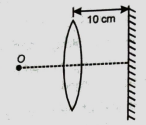The diameter of a plano-convex lens is 5 cm and thickness at the centre is 5 mm. If the refractive index of the material of the lens is 1.5, the focal length of the lens is (approximately)
1. 13 cm
2. 15 cm
3. 20 cm
4. 6.35 cm
A point object O is placed at distance 20 cm from a biconvex lens of radius of curvature 20 cm and =1.5. The final image produced by lens and mirror combination will be at

(1) 10 cm from the mirror
(2) 20 cm from lens
(3) -20 cm from lens
(4) -15 cm from the mirror
If the angle of a triangular prism is A and the refractive index of the material is , then under what condition will there be no emergent ray?
1.
2.
3.
4.
A thin lens whose power is +2D is cut into two pieces perpendicular to the principal axis. The focal length of each part will be
(1) 1 m
(2) 0.1 m
(3) 75 cm
(4) 0.05 m
A light ray is incident at an angle of on one face of a prism of a refractive angle . If light ray grazes the second face, then the refractive index of the material of prism is-
1.
2.
3.
4.
The near point of a hypermetropic eye is \(1~\text{m}.\)What is the power of the lens required to correct this defect?
1. \(-3~\text{D}\)
2. \(+3~\text{D}\)
3. \(+1~\text{D}\)
4. \(-1.75~\text{D}\)
The minimum magnifying power of an astronomical telescope is \(40\). If the length of the telescope is \(205\) cm, then the focal length of its field lens is:
1. \(5\) cm
2. \(200\) cm
3. \(40\) cm
4. \(140\) cm
A boy with defective eye-sight cannot see things beyond 50 cm. The corrective lens required has the power:
1. +1 D
2. +2 D
3. -1 D
4. -2 D
The focal lengths of the objective and eyepiece of a terrestrial telescope are 50 cm and 10 cm respectively. The magnifying power of the telescope when the final image is formed at infinity is
(1) 3.75
(2) -2.5
(3) -4.25
(4) +5
A convex mirror of focal length \(20~\text{cm}\) forms an image that is a quarter of the object's size. The distance of the object from the mirror is:
1. \(50~\text{cm}\)
2. \(-60~\text{cm}\)
3. \(-40~\text{cm}\)
4. \(-70~\text{cm}\)






